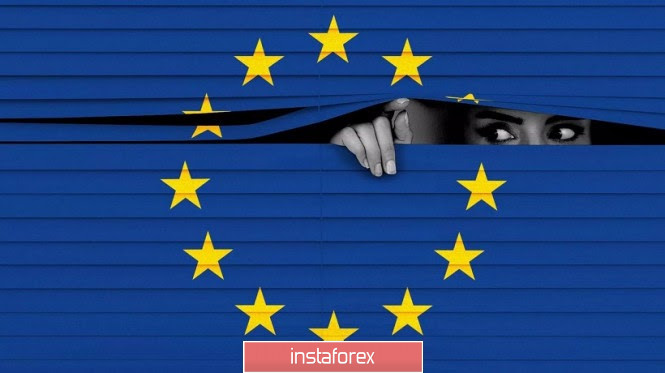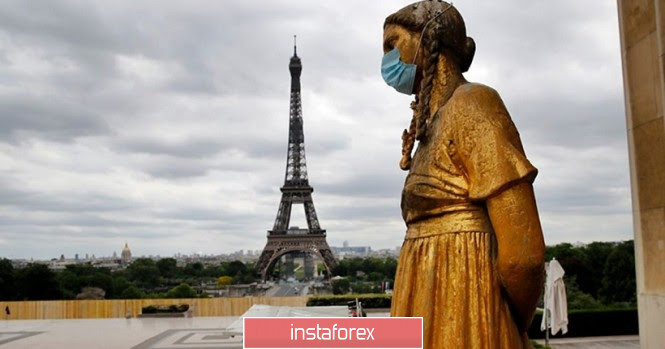The US Dollar index has again consolidated within the 93rd figure. Over the past two days, the indicator has gradually gained momentum, reacting to the growth of anti-risk sentiment in the foreign exchange market. But during the Asian session on Thursday, the index actually froze in place. The upward momentum faded, after which the major Dollar pairs fell flat. This includes the Euro-Dollar pair, which managed to stay within the 17th figure. Now buyers of the EUR/USD pair are making weak attempts to correct growth, although they clearly do not have enough strength. However, the greenback's failure to develop a large-scale offensive serves as a wake-up call for Dollar bulls. The strength of the Dollar is the Coronavirus factor, the power of which may run out in the very near future.
It is worth recalling the classic principle of the currency market to "buy on rumors, sell on facts". Rumors that key European countries are preparing to tighten quarantine restrictions were circulating last week, when there was a widespread increase in the number of infections. In the forefront of events was France, which imposed a curfew (at night) in the country's largest cities. Similar measures were taken in the Czech Republic and the Netherlands.

The rate of spread of COVID-19 increased so this week, the market again started talking about the introduction of a full lockdown in the EU countries. Against the background of such rumors, the truth of which was supported by medical reports and comments from some politicians, the Dollar began to gain momentum. The greenback has regained its status as the main defensive asset, even despite its own array of problems related to the political election in the United States. But the fear of a lockdown was stronger so the dollar index soared up and the price of EUR/USD, respectively, collapsed to the base of the 17th figure.
Germany and France decided on further steps to counter the spread of the epidemic. It turned out that Berlin decided to introduce the so-called "soft lockdown", which will be in effect throughout November. During this time, all leisure businesses will be closed (theaters, cinemas, fitness clubs, swimming pools, casinos, and so on). Almost all service-based businesses (beauty, tattoo and massage parlors) will also be closed. In addition, restaurants and cafes will be closed in November-- with the exception of those that sell takeaway food. All sports competitions will be held without spectators. In general, citizens were ordered to limit social contacts outside their homes to the absolute minimum. At the same time, industrial enterprises, wholesale, and retail trade enterprises (although with restrictions on occupancy), as well as schools and kindergartens continue to operate in the country.
As for France, they decided to return to the regulation of self-isolation. Mass events will be canceled, while gathering in places like restaurants and bars will be prohibited. There is no question of a full lockdown. Restrictions mainly apply to service companies.
Spain and Italy increased the quarantine restrictions but did not decide on a full lockdown. In Italy, all cafes, restaurants, cinemas, and gyms were closed. So far, these restrictions have been going on for two weeks. Spain has so far only imposed a night curfew (except for the Canary Islands).
Discussing the possible consequences of the second wave of the pandemic, many experts said that Europe and the United States could repeat the events that happened last spring. However, in my opinion, the current reaction of the authorities differs from the reaction of six months ago.
Firstly, major European countries do not decide on a comprehensive lockdown. The measures taken are softer, more local in nature. Second, at the beginning of this year, no one knew how long the lockdown would last. To date, it is known that several weeks of strict restrictions are needed to extinguish the wave of morbidity (an example of this is the Australian state of Victoria, where the incidence dropped to zero after a five-week quarantine). That is why the Germans announced the end date of the soft lockdown: November 30. The French, Spanish and Italians also agreed to discuss the feasibility of quarantine restrictions every two weeks.
Lastly, society's response to increased restrictions is now more severe. In particular, in Italy, clashes between protesters and the police have been going on for several days. In the Czech Republic, Great Britain, and Germany, large-scale protests are being held against the strengthening of quarantine. This nuance should also be taken into account when assessing the prospects for increasing lockdown in Europe.

The panic over the possibility of total lockdown throughout Europe is likely to subside due to the obvious discrepancy with the real steps of the authorities. Of course, even a soft lockdown will negatively affect the European economy but in my opinion, the previous market reaction was exaggerated. All this suggests that the Coronavirus factor will take a back seat in the medium term. The Euro will focus on the results of the October meeting of the ECB. The US Dollar is being affected by the political climate of the country and discussion of a new stimulus package. In my opinion, long positions are still relevant for the pair in the medium term (until next Tuesday, November 3). The likelihood of a prolonged period of political uncertainty will put pressure on the greenback, which may actively lose its positions on the eve of the election. Considering the goals of corrective growth, we can identify two positions: 1.1790 (the upper boundary of the Kumo cloud, which coincides with the Bollinger Bands and Tenkan-sen line on the daily chart) and 1.1860. This is the upper line of the Bollinger Bands on the same timeframe.
The material has been provided by InstaForex Company - www.instaforex.com